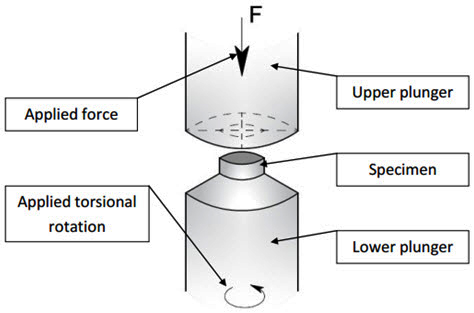The High Pressure Torsion (HPT) Process
Abstract
High Pressure Torsion (HPT) is a severe plastic deformation technique that produces ultrafine-grained materials with superior mechanical properties. This process compacts materials under extremely high pressure between two plungers while applying torsional rotation, resulting in nanocrystalline and ultrafine-grained microstructures. HPT offers significant advantages in producing materials with enhanced strength and ductility compared to conventional coarse-grained materials. Despite limitations in sample geometry and size scalability, recent developments including ring HPT and high-pressure sliding have expanded the process's industrial applicability. The technique serves as both a research tool for investigating deformation mechanisms and a practical method for consolidating nano-structured powders without compromising material properties.
Introduction to Severe Plastic Deformation and HPT
Among the various severe plastic deformation (SPD) techniques available today, the High Pressure Torsion process stands out as one of the most powerful methods for preparing ultrafine-grained materials. This superiority stems from the process's ability to generate non-homogeneous deformation with large strain gradients, resulting in exceptional microstructural refinement. Ultrafine-grained and nano-grained materials produced through HPT demonstrate significant advantages over their coarse-grained counterparts, particularly in terms of enhanced strength and improved ductility.
HPT Process Mechanics and Equipment
The High Pressure Torsion process operates through a sophisticated yet straightforward mechanism. Materials are compacted under extremely high pressure between two steel plungers using a hydraulic system. The process accommodates various starting materials, including bulk materials and metal powders, making it versatile for different applications.

Figure 1: Schematic view of the high pressure torsion process
The equipment configuration features an upper plunger that remains fixed during operation, while the lower plunger performs torsional rotation at variable speeds measured in revolutions per minute. The critical sequence involves first applying compressive pressure, followed by the initiation of rotational movement. This combination of high pressure and torsional deformation generates substantial plastic strains throughout the material, ultimately producing fully dense bulk materials with nanocrystalline and ultrafine-grained microstructures.
Process Limitations and Challenges
The HPT process faces three primary limitations that affect its industrial scalability. First, the traditional disk-shaped sample geometry proves less suitable for many industrial applications compared to more practical forms such as wires or sheets. Second, sample dimensions are typically restricted to a maximum diameter of 35 millimeters to maintain the necessary high pressure levels. Third, the strain distribution varies proportionally with distance from the disk center, creating an inhomogeneous microstructure across the sample diameter.
The scalability challenge becomes apparent when considering the massive forces required for larger samples. Processing a disk with a 500-millimeter diameter under 2 GPa pressure would require a compression load of 39,000 tons, making such operations practically unfeasible with current equipment limitations.
Advanced HPT Variations and Solutions
Ring HPT Technology
To address the limitations of traditional disk HPT, researchers developed ring HPT technology through simple modifications to the original design. This innovation offers several advantages over conventional disk processing. Ring HPT eliminates the less-strained, coarse-grained center region that typically characterizes disk samples, while simultaneously enabling sample scaling up to 100 millimeters in diameter. For a ring with a 500-millimeter outer diameter and 3-millimeter width, the required compression load reduces dramatically to 940 tons under 2 GPa pressure.
High-Pressure Sliding (HPS)
High-Pressure Sliding represents another significant advancement in severe plastic deformation technology. This process specifically targets the production of sheet metallic materials, generating samples with dimensions of 5 millimeters in width, 0.8 millimeters in thickness, and 100 millimeters in length. HPS processing of a 500-millimeter length sheet with 5-millimeter width requires only 500 tons of compression load under 2 GPa pressure, making it more accessible than traditional disk HPT for certain applications.
Research Applications and Material Consolidation
Beyond its manufacturing applications, HPT serves as an invaluable research tool for investigating the relationships between cumulative strain, applied pressure, and rotational speed on material structure and properties. This capability makes it essential for understanding fundamental deformation mechanisms and optimizing processing parameters.
The process excels in consolidating nano-structured powders, demonstrated successfully with materials such as cryomilled Al-7.5wt.% Mg structures. This application proves particularly valuable in powder metallurgy, where achieving full density while maintaining nanostructure presents significant challenges.
Advantages in Pure Metal Processing
HPT offers unique advantages in processing pure metals, particularly aluminum. Traditional approaches to strengthening aluminum involve adding alloying elements to improve strength and hardness properties. However, this conventional alloying approach typically results in the deterioration of other valuable properties, such as electrical conductivity.
High Pressure Torsion provides an alternative pathway by inducing high strength in pure metals without requiring alloying elements. This capability preserves the inherent properties of pure metals while achieving the desired mechanical enhancement, making HPT particularly attractive for applications where both strength and conductivity are critical requirements.
Conclusion
The High Pressure Torsion process represents a sophisticated severe plastic deformation technique that continues to evolve through technological innovations. While traditional limitations in sample geometry and size scaling persist, developments such as ring HPT and high-pressure sliding demonstrate the process's adaptability to industrial requirements. The technique's dual role as both a research tool and practical manufacturing process positions it as a valuable technology for producing advanced materials with tailored microstructures and enhanced properties.
Find Instantly Thousands of Metallography Diagrams!
Total Materia Horizon contains a unique collection of metallography images across a large range of metallic alloys, countries, standards and heat treatments.

Get a FREE test account at Total Materia Horizon and join a community of over 500,000 users from more than 120 countries.